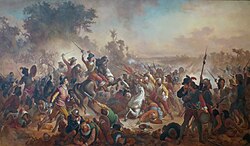Dutch Empire
The Dutch Empire owned several territories that were in control by the Dutch Republic (also known as the United Provinces). The Dutch had created colonial empires, which were similar to those of Portugal and Spain. The Dutch used their skills in shipping and trade with other empires. However, they were trying to be independent from Spain. With the British, the Dutch first built up colonies. The colonies were based on state capitalist corporate colonialism by the Dutch East and the West India Companies. The Dutch explored and went on voyages. Some of them were led by Willem Barents, Henry Hudson and Abel Tasman, who found new places for Europeans.
Dutch Empire | |
|---|---|
 An anachronous map of the Dutch colonial Empire. Light green: territories administered by or originating from territories administered by the Dutch East India Company; dark green the Dutch West India Company.
Countries today
|
The Dutch naval power was increasing. The Netherlands began to dominate global commerce during the second half of the 17th century. This was called the Dutch Golden Age. The Netherlands lost many colonies and its global power to the British after the country fell to French armies during the French Revolutionary Wars. The rest of the Dutch Empire (such as the Dutch East Indies) were in control of the Dutch until the decline of European imperialism afterWorld War II.
Today, the Netherlands are part of the Kingdom of the Netherlands. The Netherlands, Aruba, Curaçao and Sint Maarten form the Kingdom of the Netherlands.
Dutch Empire Media
The Portuguese victory at the Battle of Guararapes ended Dutch presence in Brazil.
Primary Dutch and Portuguese settlements in Asia, c. 1665. With the exception of Jakarta and Deshima, all had been captured by the Dutch East India Company from Portugal.[1]
Dutch conquests in the West Indies and Brazil[a]
Dejima trading post in Japan, c. 1805
Sukarno, leader of the Indonesian independence movement
Contemporary countries and federated states which were significantly colonised by the Dutch. In the Netherlands, these countries are sometimes known as verwantschapslanden (kindred countries).
Other websites
- (in Dutch) De VOCsite
- Dutch and Portuguese Colonial History
- (in Dutch) VOC Kenniscentrum Archived 2023-08-14 at the Wayback Machine
- ↑ Boxer 1965, p. 24.
Cite error: There are <ref> tags on this page, but the references will not show without a {{Reflist|group=lower-alpha}} template or a <references group="lower-alpha"/> tag.










